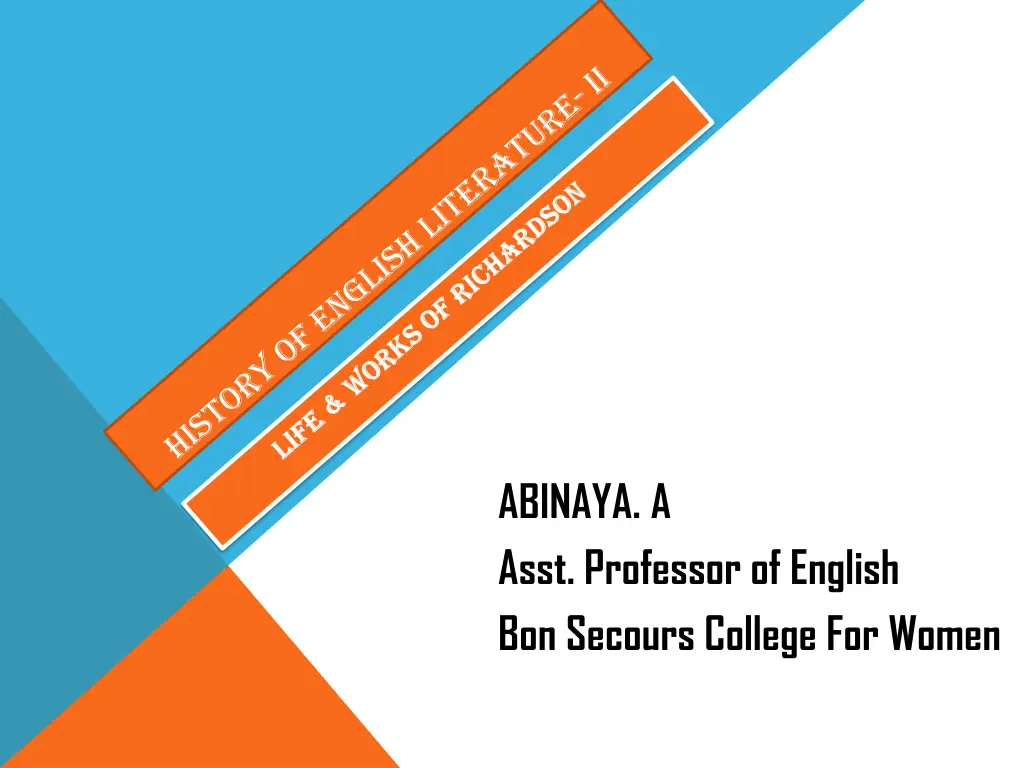
Life and Works of Samuel Richardson: An Overview
Explore the life and literary contributions of Samuel Richardson, a pioneer of the modern novel. From his humble beginnings to the publication of acclaimed works like "Pamela" and "Clarissa," delve into his significant impact on the literary world with this comprehensive overview.
Download Presentation

Please find below an Image/Link to download the presentation.
The content on the website is provided AS IS for your information and personal use only. It may not be sold, licensed, or shared on other websites without obtaining consent from the author. If you encounter any issues during the download, it is possible that the publisher has removed the file from their server.
You are allowed to download the files provided on this website for personal or commercial use, subject to the condition that they are used lawfully. All files are the property of their respective owners.
The content on the website is provided AS IS for your information and personal use only. It may not be sold, licensed, or shared on other websites without obtaining consent from the author.
E N D
Presentation Transcript
ABINAYA. A Asst. Professor of English Bon Secours College For Women
LIFE OF RICHSRDSON Samuel Richardson was born on 19thAug 1698, in Mackworth, Derbyshire. He received little education owing to his father s poverty. In 1706 he was apprenticed to a printer and soon set up his own printer shop. He wrote many novels in the epistolary form. He died in the year 1761.
HIS WORKS Richardson published his first novel Pamela: Virtue Rewarded in 1740 followed by Clarissa: The History of a young Lady and The History of Sir Charles Grandison. He is generally agreed to be one of the chief founders of the modern novel. All his novels were epistolary (a story written in the form of letters).
Pamela The novel was an experiment, but it allowed Richardson to create a complex heroine through of her letters. It was the first example of a best seller in the history of the English novel. This is an epistolary novel, most of the letters are written by the protagonist, Pamela Andrews, a young servant girl, to her servants. Despite its simplicity of subject, it was so fresh in character and interest that it scored an instant and sensational success. The novel was immensely popular not only in England but also in Eurpoe where it was soon translated into all the major language and turned into a play.
Clarissa The Adventures of a young Lady is Richarson s Masterpiece, also written in epistolary form. It is still regarded as, in its own way, one of the greatest of 18th century novels. Clarissa Harlowe is a beautiful 18year old woman considered an exemplary woman by everyone around her, but the members of the family are avaricious and eager to improve their standing in the world. It is also noteworthy as containing Richardson s most remarkable character study in the scoundreal, Lovelac, whose name has become proverbial.
SIR CHARLES GRANDISON Third epistolary novel It transforms the letter writing from telling of personal insights and explaining feelings into a means for people to communicate their thoughts on the actions of others and for the public to celebrate virtue. The hero of the novel was intended to be a model of aristocratic manners and virtues for the middle-class people.
MERITS & DEMERITS OF RICHARDSONS NOVELS Richardson is generally agreed to be one of the chief of the modern novel All his novels were epistolary, a form he took earlier works in English and French and which he raised to a level not attained by any of his predecessors. His stories drga; and their machinery is very clumsy. His is the art of the infinitely little, and his effects are built up out of thousands of small and seemingly trivial things. In many of its fundamental characteristics his genius was rather femine than masuline. His first-hand knowledge of the world was small, and his view extremely narrow, and the moral element in his work suffered greatly in consequence.




